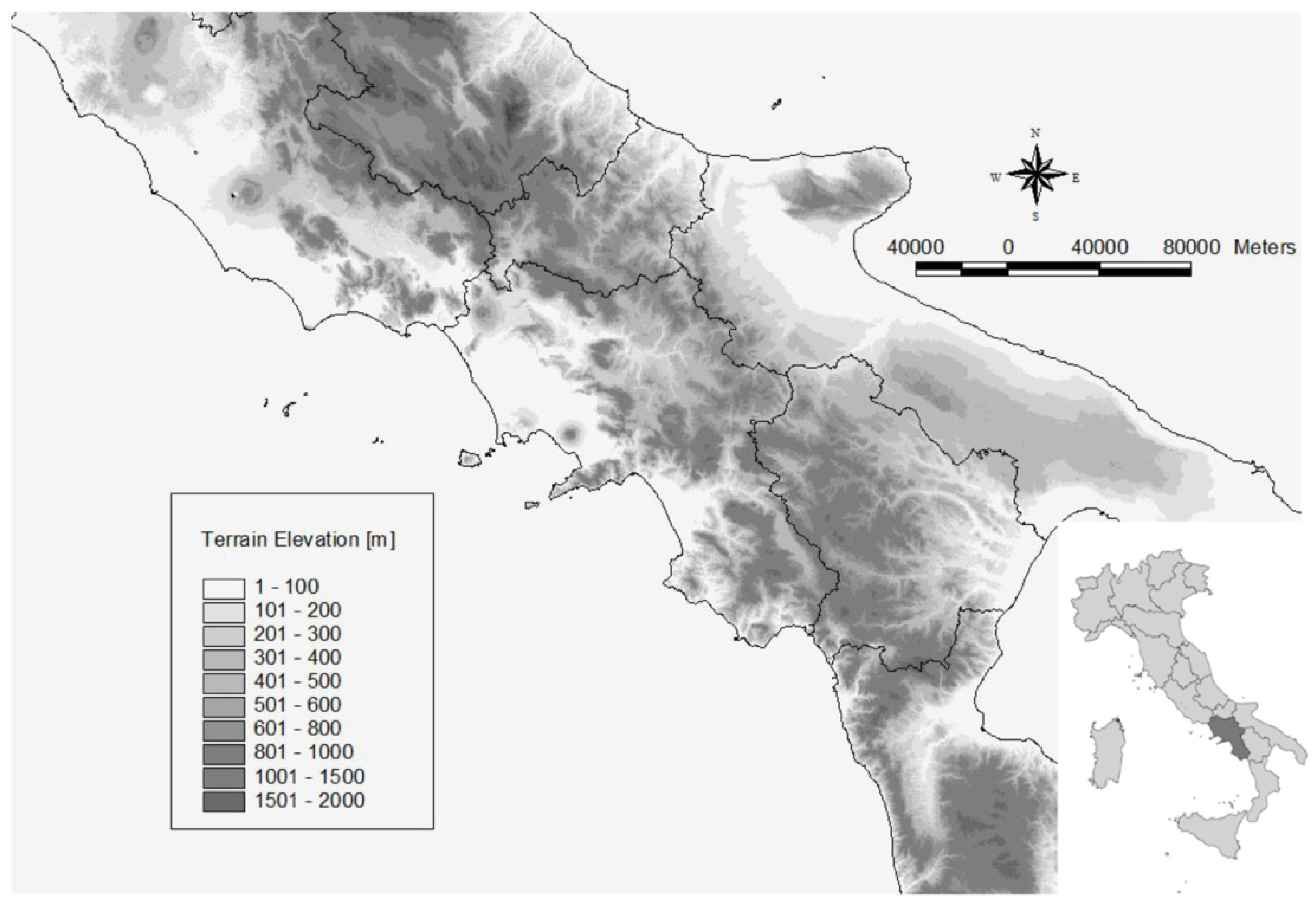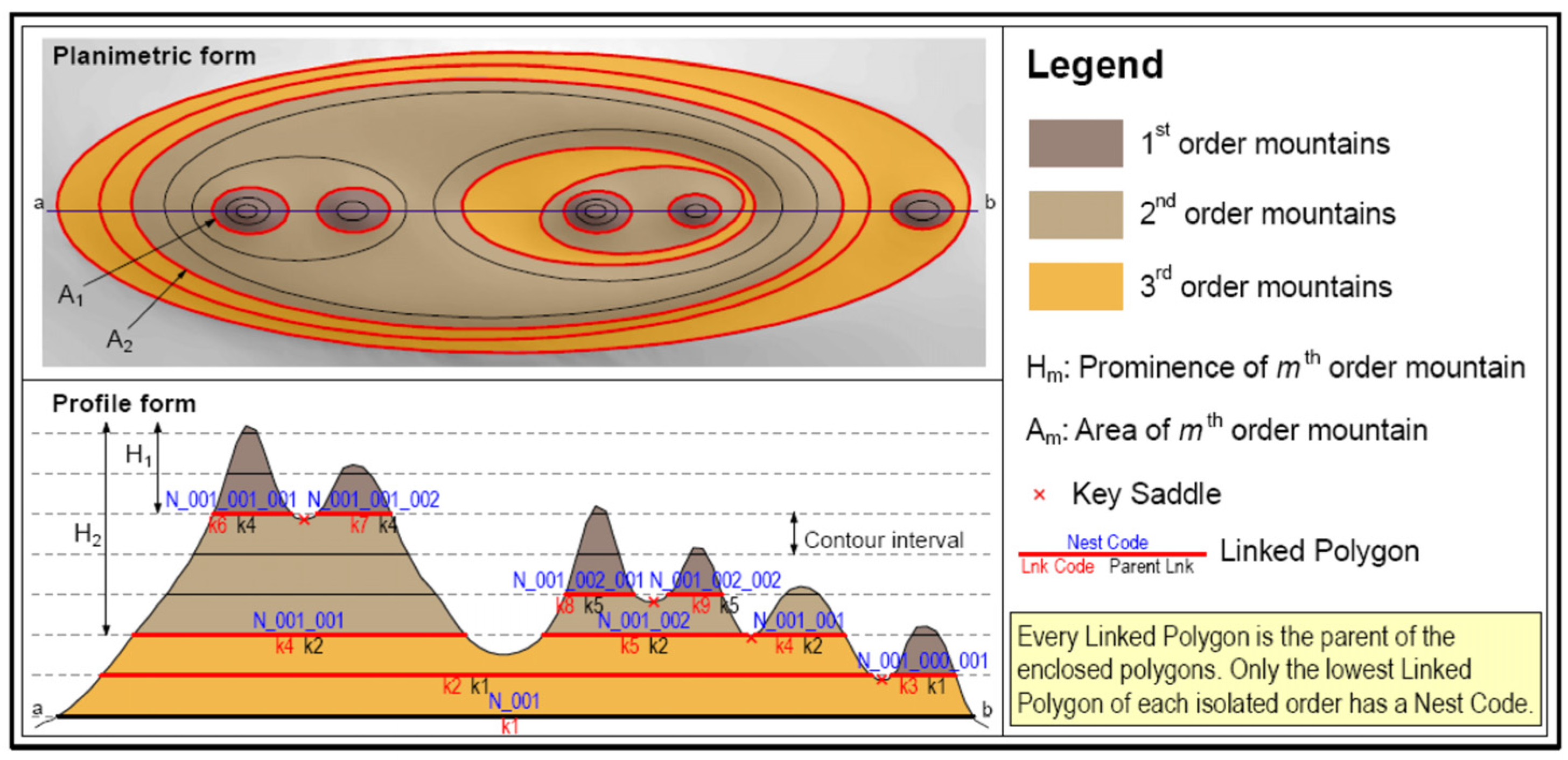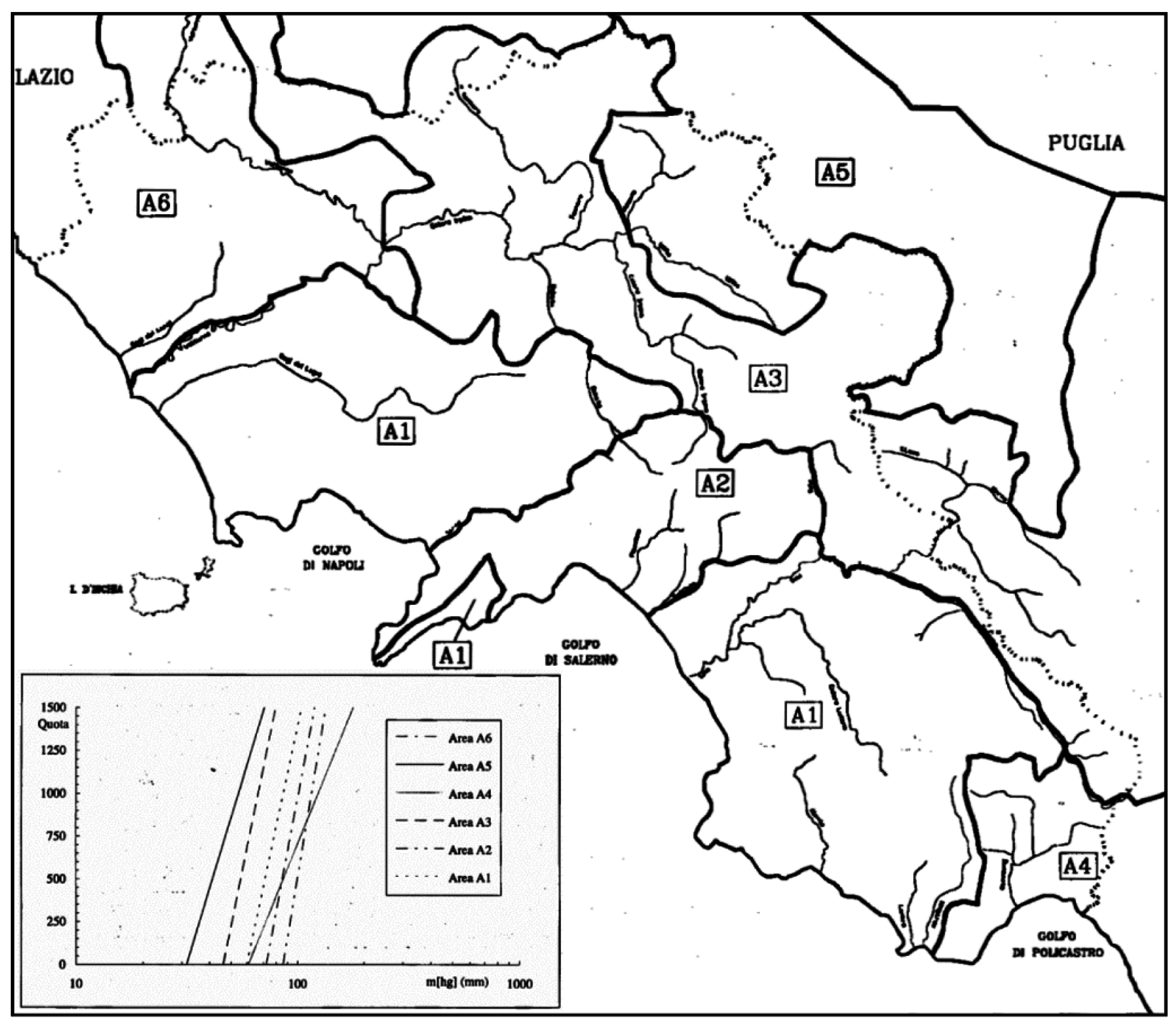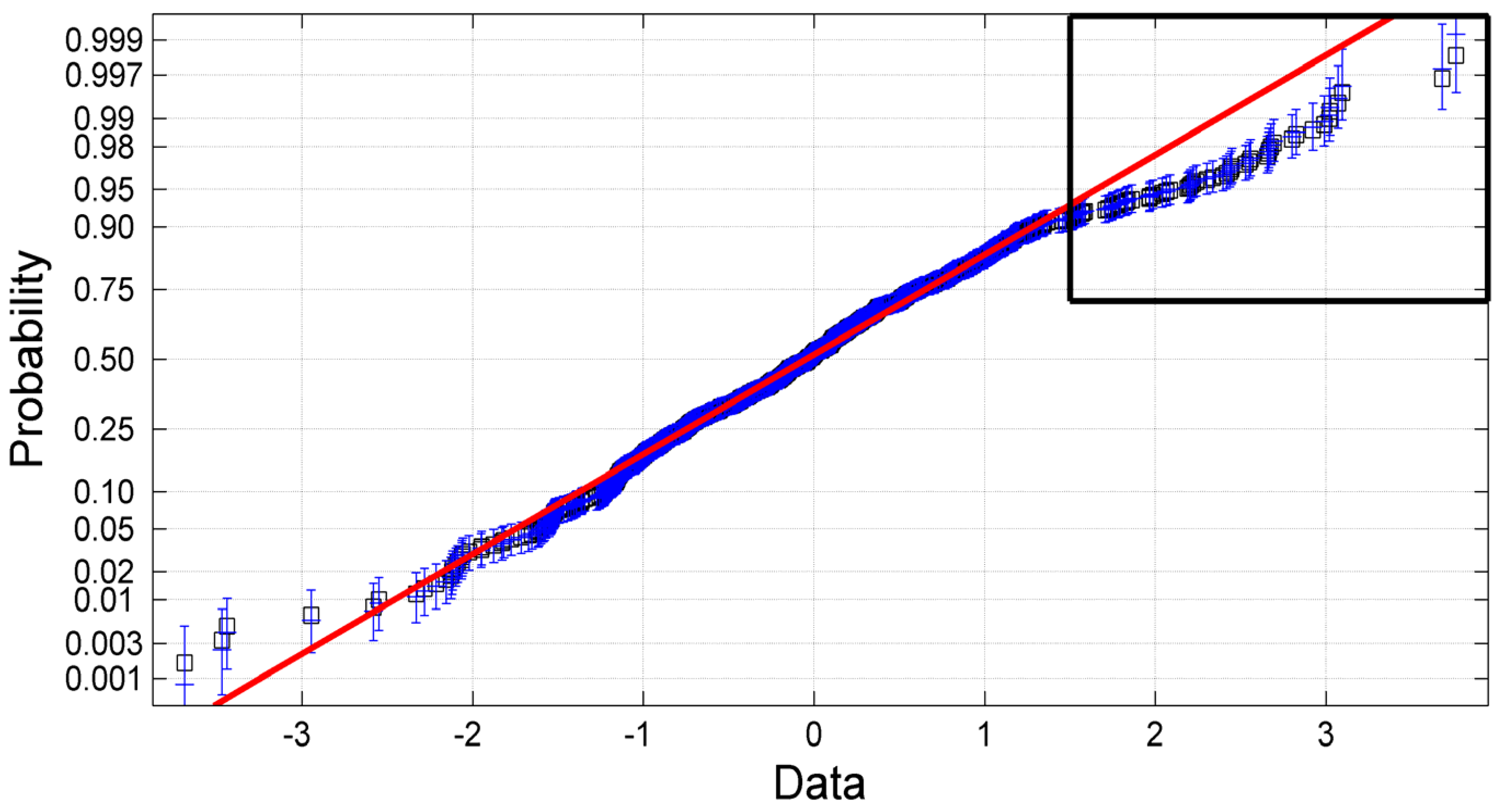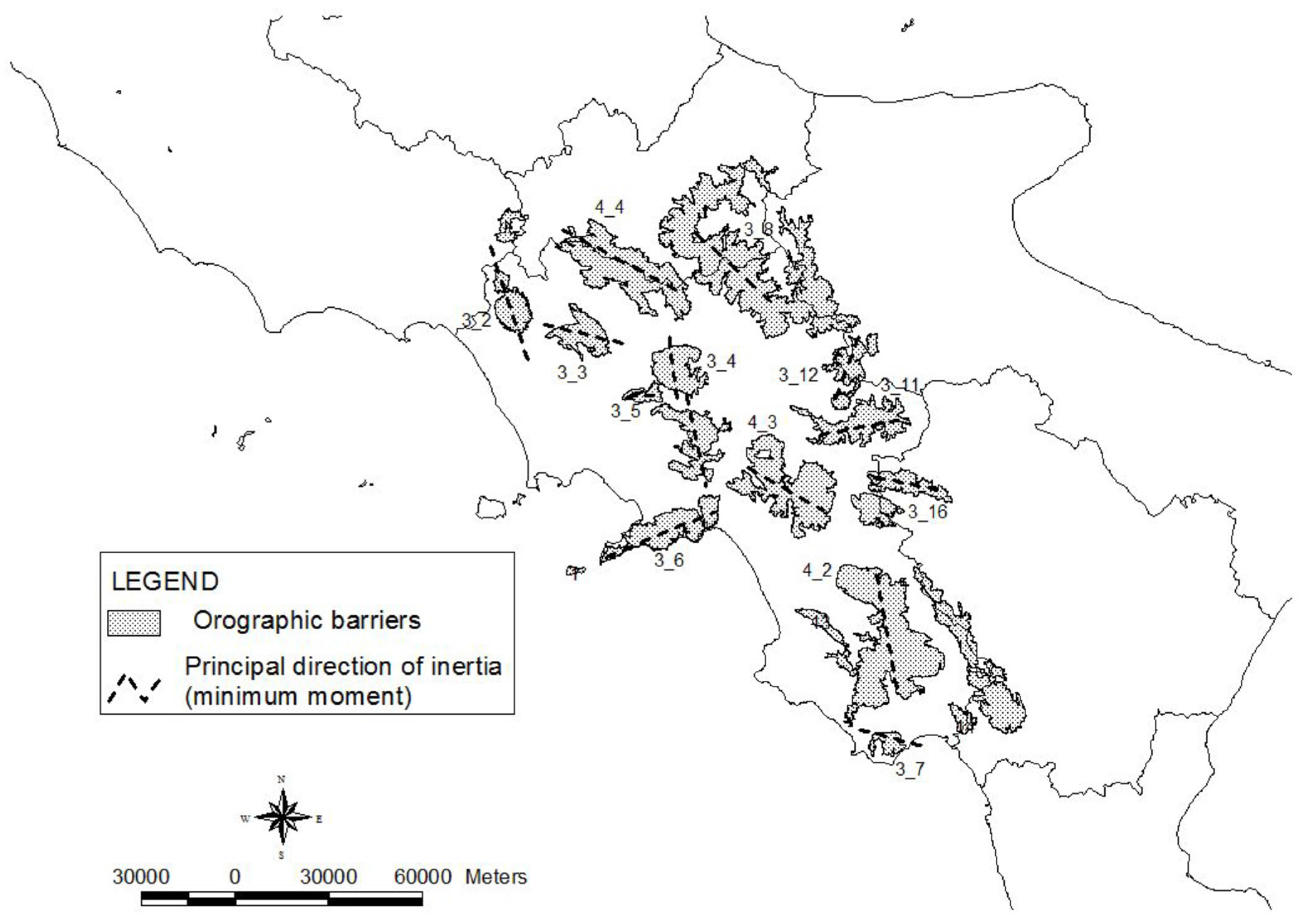2.3.1. The VAPI Model for Extreme Rainfall in the Region
The most recent and complete analysis of extreme rainfall at a regional scale for the study area was conducted within the VAPI national project [
10] and described in the VAPI Campania regional report [
9].
The VAPI procedure is based on the use of TCEV (Two Components Extreme Value, [
17]) as a parent probabilistic model for the annual maxima of daily and sub-daily rainfall. The probabilistic model is coupled with a three level hierarchical procedure for the regional estimation of the parameters. The regional model is a simple model of homogeneous region at each level [
8].
The first and second levels of regionalization deal with the regional estimation of the shape and scale parameters of the distribution. At both levels, the whole region can be considered homogeneous, with the shape and scale parameters that assume unique values everywhere.
At the third level, the regionalized variable is the mean of the annual maxima of daily (and hourly) rainfall. Here we report only the results for daily rainfall, which are the data analyzed in our work.
The regional analysis conducted within the VAPI project led to the identification of six homogeneous sub-regions at the third level. In each sub-region, a linear relationship between elevation and logarithm of mean annual daily rainfall maxima was estimated through a regression analysis.
The boundary of the homogeneous sub-regions are represented in
Figure 4 along with the lines representing the six linear regressions that were fitted.
Figure 4.
Map of the six homogeneous sub-regions for the mean annual daily rainfall maxima and linear relationships with elevation from VAPI Campania report. Reproduced with permission from Rossi, F
. et al. Valutazione Delle Piene in Campania; Published by CNR-GNDCI, 1995 [
9].
Figure 4.
Map of the six homogeneous sub-regions for the mean annual daily rainfall maxima and linear relationships with elevation from VAPI Campania report. Reproduced with permission from Rossi, F
. et al. Valutazione Delle Piene in Campania; Published by CNR-GNDCI, 1995 [
9].
2.3.2. Identification of Spatial Outliers in Extreme Rainfall
In a recent work, we identified areas with enhanced spatial variability of the mean of the annual daily rainfall maxima through an innovative statistical procedure [
7]. The procedure demonstrates how linear geostatistics is not able to capture the spatial variability of the regionalized variable in areas with a strong orographic forcing. It is an iterative statistical procedure applied to the logarithmic transformation of the original series of the annual daily rainfall maxima. The logarithmic transform was applied in order to obtain an approximately Gaussian field, for which linear geostatistics works the best.
Let
Y(
x) be the mean of the annual maxima of daily rainfall,
Z(
x) denote its logarithmic transformation as follows:
The detection of the spatial non linearity, where the term “non-linearity” is used to characterize areas where linear geostatistics fails, due to an enhanced small scale variability of the field Z(x) was performed by analyzing the residuals of a cross-validation procedure in an innovative way.
The Kriging with Uncertain data (KUD) [
18] estimator was run for the jack-knife estimation of the field in all the sampling points and then the standardized cross-validation residuals were calculated as follows:
where
is the observed value of the field at sampling sites
xi,
is the jackknife KUD estimation of the field at sampling sites
xi and
denotes the estimated predictor variance (for theoretical details, refer to [
7]).
The cross-validation residual at a given sampling site, as defined in Equation (2), represents the sum of the interpolation and the sampling errors at that site. Under the hypotheses of the kriging predictor, the standardized cross-validation residuals should follow a standardized Gaussian distribution. Because of the orographic effects, instead, there are “anomalous” errors in some gauges. The “anomalous” errors can be identified as outliers on the upper tail of the error probability distribution in the Normal Probability Chart, which facilitates the comparison between the empirical and the expected theoretical distribution of the residuals. We considered as outliers the residuals whose 95% confidence interval (in blue in
Figure 5) deviates from the straight line (in red in
Figure 5), which represents the theoretical distribution (
i.e., standardized Gaussian distribution) of the residuals on the Normal Probability Chart (
Figure 5). Hereinafter, we refer to these sampling sites/rain gauges where the outliers occur as “anomalous” sites/rain gauges or as spatial outliers. In these sites, the kriging predictor fails with an unacceptable underestimation of the field.
Figure 5.
Normal Probability Plot of the standardized residuals from cross-validation. Reproduced with permission from Furcolo, P.; Pelosi, A.; Rossi, F. Statistical identification of orographic effects in the regional analysis of extreme rainfall.
Hydrol. Process. 2015 [
7].
Figure 5.
Normal Probability Plot of the standardized residuals from cross-validation. Reproduced with permission from Furcolo, P.; Pelosi, A.; Rossi, F. Statistical identification of orographic effects in the regional analysis of extreme rainfall.
Hydrol. Process. 2015 [
7].
Figure 5 displays the Normal Probability Chart of the standardized residuals. In the upper tail of the distribution, within the black square, there are the anomalous errors, which significantly deviate from the theoretical distribution. These errors correspond to rain gauges marked as anomalous in
Figure 3.
The statistical procedure detected the presence of 19 spatial outliers in the study area. The following step was to interpret the nature of these spatial outliers and highlight the physical factors that influence the rainfall field in such a way to produce a rainfall amplification that is so evident in the mean of the annual maxima.
In
Table 2, we show some basic statistics of the data (
i.e., annual daily rainfall maxima) in the study area, discerning between the anomalous subset and the remaining rain gauges. These statistics reveal that the average value of the field over the region (
i.e., the average mean) is much higher in the anomalous gauges than in the other gauges of the region while the other statistics (
i.e., average coefficient of variation,
Cv, and average skewness) do not change as much. In particular, the circumstance that the skewness does not increase for the anomalous subset suggests that the mean is not affected by the presence of a few very intense events in the series but there is a more general amplification of the events producing the annual maximum.
Table 2.
Statistics of the data in the study area, with distinction among the whole dataset, the anomalous subset and the remaining rain gauges [
7].
Table 2.
Statistics of the data in the study area, with distinction among the whole dataset, the anomalous subset and the remaining rain gauges [7].
| Set of Rain Gauges | Number of Rain Gauges | Average Mean (mm) | Average Cv | Average Skewness |
|---|
| ALL | 245 | 69.8 | 0.353 | 1.254 |
| ANOMALOUS | 19 | 101.5 | 0.382 | 1.229 |
| NON ANOMALOUS | 226 | 67.1 | 0.351 | 1.256 |
In a climatologically homogeneous region like the one analyzed, orography may be identified as the main characteristic that may cause this amplification of the events producing the annual maxima. This is confirmed by a first examination of the results by comparing the anomalous rain gauges placed in the study area with the location of the orographic areas defined in
Section 2.
The results of the comparison are interesting (see
Table 3 for the details):
- ▪
The anomalous sites are located very close to orographic barriers: about 70% of the anomalous rain gauges are placed in orographic areas whereas only less than 20% of the gauges are located in those areas.
- ▪
About 30% of the rain gauges placed in orographic areas are anomalous, against 3% of anomalous gauges in the other areas.
Table 3.
Main statistics referred to the location of the “anomalous” rain gauges.
Table 3.
Main statistics referred to the location of the “anomalous” rain gauges.
| Areas | Number of Rain Gauges | Number of Anomalous Rain Gauges | % |
|---|
| Study area | 245 | 19 | 7.76 |
| Orographic areas | 47 | 13 | 27.7 |
| % | 19.2 | 68.4 | – |
